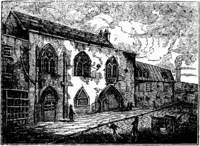Eastbridge Hospital of St Thomas the Martyr, Canterbury
| Eastbridge Hospital of St Thomas the Martyr | |
|---|---|
 Eastbridge Hospital of Saint Thomas the Martyr. | |
| Geography | |
| Location | Canterbury, England, United Kingdom |
| Coordinates | Coordinates: 51°16′47″N 1°04′42″E / 51.27985°N 1.07833°E |
| Services | |
| Emergency department | No Accident & Emergency |
| Helipad | No |
| History | |
| Founded | 12th century |
| Links | |
| Lists | Hospitals in England |
The Hospital of St Thomas the Martyr of Eastbridge was founded in the 12th century in Canterbury, England, to provide overnight accommodation for poor pilgrims to the shrine of St Thomas Beckett. It is now one of the ten almshouses still providing accommodation for elderly citizens of Canterbury[1] and is a grade I listed building. [2]
History
The hospital is situated on the King's-bridge, near the Westgate, in Canterbury. It was established sometime after the death of Thomas Becket (1170), possibly as early as 1176, when Canterbury Cathedral became a site of pilgrimage; the hospital provided accommodation for the pilgrims. The earliest name recorded as founder is that of Edward FitzOdbold c. 1190, with further endowments by Archbishop Hubert Walter about 1203.[1] For many years, no special statutes were enacted, nor were any rules laid down for the treatment of pilgrims.
In the fourteenth century the Hospital was reformed by Archbishop John de Stratford, during the reign of Edward III; he created ordinances, as well as a code of regulations to be acted on concerning pilgrims. He ruled that every pilgrim in health could rest in the lodgment for one night at the cost of four pence, that weak and infirm applicants were to be preferred to those with better health, and that women "upwards of forty" should attend to the bedding and administer medicines to the sick. He also appointed a Master in priest's orders, under whose guidance a secular chaplain served. Further lands and revenues from parishes were given by Stratford and by Archbishop Simon Sudbury.[1]

This institution survived the Dissolution of the Monasteries and other religious houses during the reigns of Henry VIII and Edward VI, although the pilgrimage to St Thomas of Canterbury did not survive this period. In 1569 Archbishop Matthew Parker issued new ordinances governing the Hospital and its Master which specified the maintenance of twelve beds for the 'wayfaring poor' and established a school in the chapel for twenty boys. This arrangement was confirmed by Archbishop John Whitgift by Act of Parliament in 1584.[1]
The school survived until 1879. The chapel was then little used until its restoration by the Master in 1927. Further restoration work has taken place during the twentieth centtury. Much of this work was financed by sale of some of the Hospital's lands at Blean at the foundation of the University of Kent in the 1960s: since the fourteenth century the Master of Eastbridge has been the Lord of the Manor of Blean. The Master is now also the rector of several of the amalgamated city parishes.[1] Since 2003, the Hospital has been cared for by an Anglican Franciscan community.[3]
A list of the Masters of the Eastbridge Hospital up to the end of the eighteenth century is given by Edward Hasted.[4]
References
- The hospital of King's Bridge from Edward Hasted, The History and Topographical Survey of the County of Kent: Volume 12 (1801), pp. 115–135.
- Hospitals in and around Canterbury from A History of the County of Kent (Victoria County History): Volume 2 (1926), pp. 209–216.
- The mirror of literature, amusement and instruction, Vol. 10, Issue 268
Notes
- 1 2 3 4 5 Derek Ingram Hill, The Ancient Hospitals and Almshouses of Canterbury, (Canterbury Archaeological Society, 1969), new edition by Marjorie Lyle (2004), ISBN 0-901589-05-5. Pp. 23-32 and 58-59.
- ↑ "Name: EASTBRIDGE HOSPITAL List entry Number: 1085030". Historic England. Retrieved 23 March 2015. line feed character in
|title=at position 26 (help) - ↑ http://www.franciscans.org.uk/Page160.htm
- ↑ Edward Hasted, The History and Topographical Survey of the County of Kent, Volume 12 (1801) pp. 115-135.